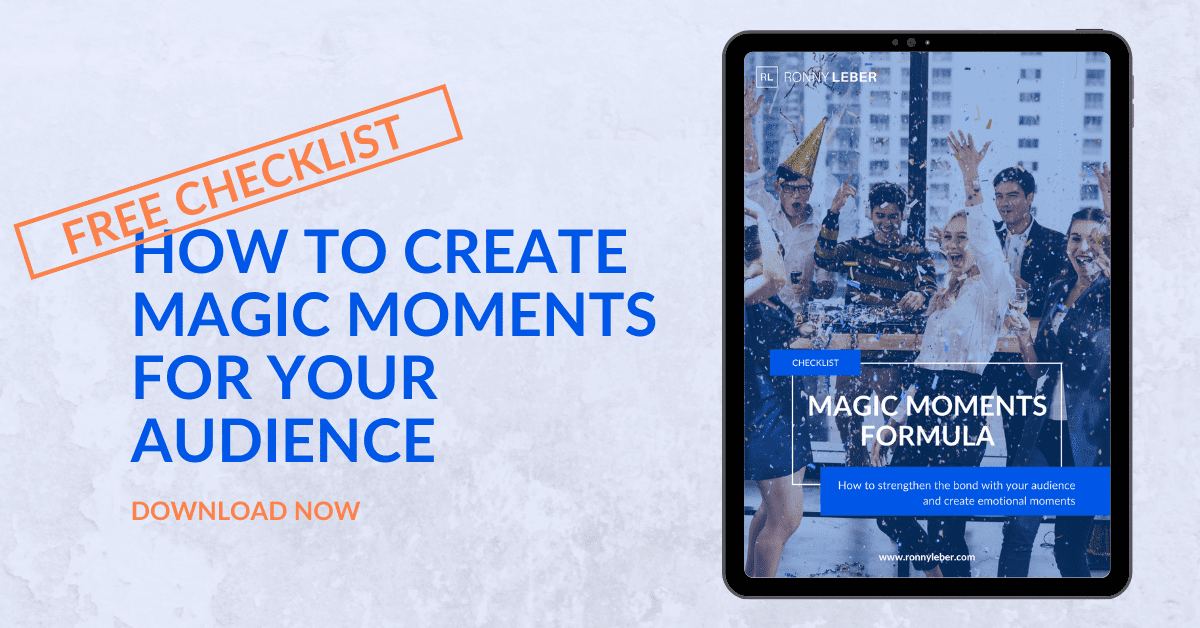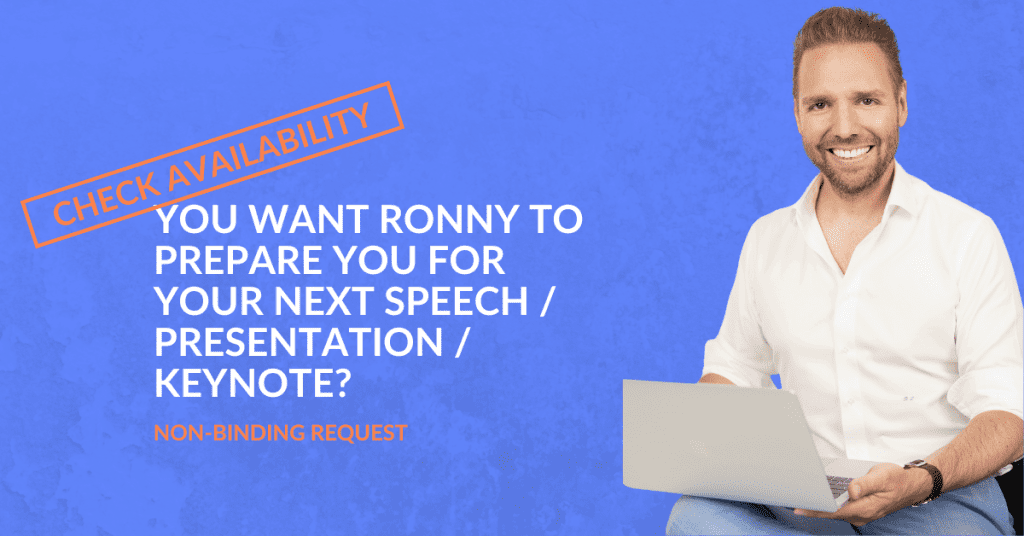7 things that make a great keynote
Imagine: you are standing on a stage and look straight into a darkened room full of people. You read enthusiasm in their faces. People are standing, applauding and cheering. You feel a wave of positive energy coming in your direction. You have just finished your keynote and have managed to tap into your audience’s emotions. They trusted you and you were able to take them on a journey. You were able to motivate and inspire them. This feeling is indescribably beautiful.
This is the result of a great keynote that every speaker wants.
Throughout the course of this blog post, I will show you what the ingredients for a brilliant speech are.
A keynote that will: –
- motivate
- inspire
- remain in the memory of your audience.
Maybe you want to give a good keynote yourself. My 7-point guide brings you closer to this goal.

Stop guessing how to WOW your audience!
We will send you our secret ingredients to WOW your audience for free! In the MAGIC MOMENTS FORMULA you can learn how to take any audience of any size and create a deep emotional experience for them in order to create a deeper emotional bond with you and your brand.
1. Why do you need an outstanding keynote?
First of all, think about what you want to achieve with a keynote.
If you want to tailor your keynote to an event, you should also be aware of its goal. The goal of the event must be clearly defined and determined in advance.
The term “keynote” refers to the vocal sound that a choir is tuned with. A keynote tunes the audience to a topic that should be seen in a larger context. This sounds very strategic, but is the actual purpose of a keynote.
A good keynote may – no, should of course – also be entertaining. With a keynote, the central message of an event is conveyed to the audience in a relaxed manner. The presentation should provide impulses, trigger a specific topic or stimulate critical discussion.
Many keynotes are only 20 or 30 minutes long, although they can last up to an hour and a half. Must be able to win the audience over to your topic and to the central idea within this short space of time. You have to do everything you can to get the goal, the product or the vision across to the audience in the best possible way.
This is where the real difficulty lies when creating a keynote. The goal is quickly recognized, but it takes experience to skilfully implement it.
2. Know your audience

Now that you have set the goal of the keynote, there is one no-less-important point: you need to know your audience.
- What is the average age of the audience?
- Are there more men or women present?
- What do the audience members do professionally and in what roles?
- What is the emotional involvement with your topic?
- Are the participants familiar with your topic or are they beginners?
- Are the attendees here voluntarily or is it “part of the job”?
A good keynote is harmoniously focused on the audience. The wording used reflects the language of the audience.
The better you know your audience, the better you can emotionally engage them. That creates trust. If the audience trusts you, that’s already half the way to a successful keynote. Above all, knowing how your audience feels about the topic is essential. Your audience will feel understood and in good hands with you.
3. Clear structure and dramaturgy are the essence of an outstanding keynote
A good speech is characterized by a clear structure and dramaturgy that fits the topic. Does my keynote follow a clear theme? Is there a comprehensible beginning, middle section and conclusion to my speech? Is my entire keynote aligned with the main objective? Do I have enough examples or stories in my subsections?
A good keynote speaker pauses in the right places and varies the tone, tempo and volume. Similar to a narrative, an excellent keynote creates dramatic tension. Good keynote speakers don’t fall out of the sky, especially when it comes to the challenge of maintaining the right tempo. This is where point 6 comes into play.
4. Creating emotions through storytelling
In addition to creating dramaturgical suspense, a keynote should also contain various magic moments. In other words: it can be emotional. Storytelling is more popular than ever, because what better way to engage the audience than a speaker using figurative and flowery words to convey a topic? The speech should be filled with life so that it can develop its own dynamic. So: your speech is given life by your stories.
Creating emotional moments is incredibly important. The audience is immediately awakened by a perhaps provocative introduction right at the beginning of the speech. That way you create interest and can gracefully move on to the main topic.
The end of the keynote can also be a real highlight. You can leave a good last impression with a concluding anecdote or striking question. In this way, the audience is encouraged to think beyond the keynote.
After all, that’s the purpose of a keynote. If your keynote is still a topic of conversation at the bar, you’ve already done a lot right.
5. Activate your audience
Not only is an audience that sits quietly and passively in its seats mind-numbingly boring for the keynote speaker; there is also a danger that the audience will miss the target and the topic. With a good speech, the audience is both energised and challenged.
But how do you do this most effectively? The answer is by challenging your audience while always listening to your listeners and viewers. The audience must feel that they are being invigorated and taken on a journey, because this is the only way to achieve a transformation on all levels.
Of course, the activation of the audience is also crucially dependent on your own energetic state. You have to be in the highest possible state yourself. If you want to spark the fire in others, you must first of all burn for it yourself. More tips on how to increase your stage presence can be found here.
6. Practice makes perfect

The perfect keynote does not fall from the sky; nor does the perfect keynote speaker. Successful keynote speakers regularly practice their speeches. They carefully prepare the content and all necessary materials. A test audience is often given the opportunity to enjoy the speech in advance so that the presentation can be optimally prepared. Many hours of work are invested until the speech is ready.
It’s not primarily about the content, but about details such as dramaturgy, structure or the rehearsal of punchlines. The right body language is also an essential part of a convincing presentation. And since the message should also travel, the right voice training is also part of the ideal preparation.
When practicing, the focus should always be on the audience. A test audience can give you helpful tips on how to immediately improve your speech. If there is no audience with whom you can practice the speech in advance, record your own speech at home with a video camera or cell phone. This gives you the opportunity to watch and optimize individual sequences over and over again.
7. Flexibility and improvisation are the key points to a great keynote
Last but not least: the ultimate discipline! What distinguishes a good keynote from an outstanding one? An outstanding keynote is characterized by the fact that the speaker does not stick rigidly to his speech, but can react flexibly to what is happening in the audience. Here, direct input from the audience can also be incorporated into the presentation. The more the audience can identify with the keynote, the more valuable the feedback.
A total focus on what is happening in the room at any time during your keynote is also valuable. For example, the technology can sometimes fail, meaning that improvisation is then called for. An often-practiced keynote leaves enough free space within the content to react flexibly to unexpected events. If you are an experienced speaker and you have already given the keynote several times, you are quite capable of changing your speech during the presentation without the audience noticing. It is important that you always keep your goal in mind, because as long as you know where you want to go, you will find a way.

Ask Ronny to coach you for your next performance
Click on the button and send a non-binding request to Ronny to be your coach for your next keynote, speech or presentation.
Keynote from an amateur or from a professional?
This question may sound a bit provocative. Basically, whether you are an amateur or a professional keynote speaker, it takes a lot of practice to deliver a captivating keynote. This is because keynotes are not just simple lectures; they are strategically-sophisticated speeches that pursue goals. Product keynotes á la Steve Jobs, for example, were crucial to Apple’s success. Even with speeches by great speakers like Bill Clinton, Tony Robbins or Arnold Schwarzenegger, nothing is left to chance.
You need time to practice and rehearse your speech and to feel comfortable on stage. Possible challenges arise when unforeseen situations arise, for example if all of a sudden the technology fails or a heckler in the audience interrupts you. Inexperienced performers will have difficulty coping with such disturbances. They lack the practice and experience to be able to improvise flexibly.
My tip: if the quality of a keynote at your event determines the well-being of your company because an innovative product is to be marketed or certain values are to be transmitted, follow the example of the big boys; leave nothing to chance and get a professional keynote-speaker.
Have you ever held or experienced a keynote yourself? What makes a keynote so special? Leave me a comment about it!









 Contact
Contact








Have you ever held or experienced a keynote yourself? What makes a keynote so special?